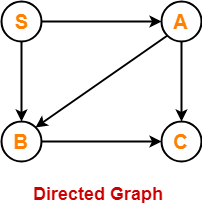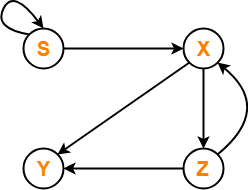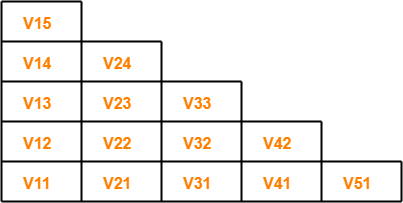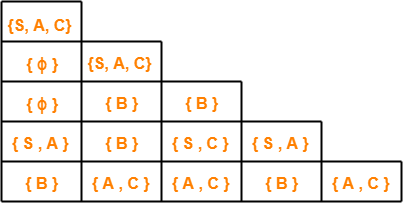Algorithm To Decide Whether CFL Is Empty Or Not-
| If we can not derive any string of terminals from the given grammar, then its language is called as an Empty Language. L(G) = ϕ |
For a given CFG, there exists an algorithm to decide whether its language is empty L(G) = ϕ or not.
Algorithm-
- Remove all the useless symbols from the grammar.
- A useless symbol is one that does not derive any string of terminals.
- If the start symbol is found to be useless, then language is empty otherwise not.
RememberThe language generated from a CFG is non-empty iff the start symbol is generating. |
Example-
Consider the following grammar-
S → XY
X → AX
X → AA
A → a
Y → BY
Y → BB
B → b
Now, let us check whether language generated by this grammar is empty or not.
The given grammar can be written as-
S → aabb
X → aX
X → aa
A → a
Y → bY
Y → bb
B → b
Clearly,
- The start symbol generates at least one string (many more are possible).
- Therefore, start symbol is useful.
- Thus, language generated by the given grammar is non-empty.
| L(G) ≠ ϕ |
NOTE-
If L(G) = { ∈ } i.e.
- If the language generated by a grammar contains only a null string,
- then it is considered as non-empty.
Algorithm To Decide Whether CFL Is Finite Or Not-
For a given CFG, there exists an algorithm to decide whether its language is finite or not.
Step-01:
Reduce the given grammar completely by-
- Eliminating ∈ productions
- Eliminating unit productions
- Eliminating useless productions
Step-02:
- Draw a directed graph whose nodes are variables of the given grammar.
- There exists an edge from node A to node B if there exists a production of the form A → αBβ.
Now, following 2 cases are possible-
Case-01:
- Directed graph contains a cycle.
- In this case, language of the given grammar is infinite.
Case-02:
- Directed graph does not contain any cycle.
- In this case, language of the given grammar is finite.
PRACTICE PROBLEMS BASED ON DECIDING WHETHER CFL IS FINITE-
Problem-01:
Check whether language of the following grammar is finite or not-
S → AB / a
A → BC / b
B → CC / c
Solution-
Step-01:
The given grammar is already completely reduced.
Step-02:
We will draw a directed graph whose nodes will be S , A , B , C.
Now,
- Due to the production S → AB, directed graph will have edges S → A and S → B.
- Due to the production A → BC, directed graph will have edges A → B and A → C.
- Due to the production B → CC, directed graph will have edge B → C.
The required directed graph is-

Clearly,
- The directed graph does not contain any cycle.
- Therefore, language of the given grammar is finite.
Problem-02:
Check whether language of the following grammar is finite or not-
S → XS / b
X → YZ
Y → ab
Z → XY
Solution-
Step-01:
The given grammar is already completely reduced.
Step-02:
We will draw a directed graph whose nodes will be S , X , Y , Z.
Now,
- Due to the production S → XS / b, directed graph will have edges S → X and S → S.
- Due to the production X → YZ, directed graph will have edges X → Y and X → Z.
- Due to the production Z → XY, directed graph will have edges Z → X and Z → Y.
The required directed graph is-

Clearly,
- The directed graph contain cycles.
- Therefore, language of the given grammar is infinite.
CYK Algorithm-
| CYK Algorithm is a membership algorithm of context free grammar. |
- It is used to decide whether a given string belongs to the language of grammar or not.
- It is also known as CKY Algorithm or Cocke-Younger-Kasami Algorithm after its inventors.
Important Notes-
Note-01:
- CYK Algorithm operates only on Context Free Grammars given in Chomsky Normal Form.
Note-02:
- The worst case running time of CYK Algorithm is Θ (n3.|G|).
- Here, n = Length of parsed string and |G| = Size of the CNF Grammar G.
Algorithm-
Deciding Membership Using CYK Algorithm-
To decide the membership of any given string, we construct a triangular table where-
- Each row of the table corresponds to one particular length of sub strings.
- Bottom most row corresponds to strings of length-1.
- Second row from bottom corresponds to strings of length-2.
- Third row from bottom corresponds to strings of length-3.
- Top most row from bottom corresponds to the given string of length-n.
Example-
For a given string “x” of length 4 units, triangular table looks like-

We will fill each box of xij with its Vij.
These notations are discussed below.
Notations Used
Notation-01: xij
xij represents a sub string of “x” starting from location ‘i’ and has length ‘j’. Example- Consider x = abcd is a string, then- Number of sub strings possible = n(n+1)/2 = 4 x (4+1) / 2 = 10 We have-
Notation-02: Vij
Vij represents a set of variables in the grammar which can derive the sub string xij. If the set of variables consists of the start symbol, then it becomes sure-
|
PRACTICE PROBLEM BASED ON CYK ALGORITHM-
Problem-
For the given grammar, check the acceptance of string w = baaba using CYK Algorithm-
S → AB / BC
A → BA / a
B → CC / b
C → AB / a
Solution-
First, let us draw the triangular table.
- The given string is x = baaba.
- Length of given string = |x| = 5.
- So, Number of sub strings possible = (5 x 6) / 2 = 15.
So, triangular table looks like-

Now, let us find the value of Vij for each cell.
For Row-1:
Finding V11
- V11 represents the set of variables deriving x11.
- x11 = b.
- Only variable B derives string “b” in the given grammar.
- Thus, V11 = { B }
Finding V21
- V21 represents the set of variables deriving x21.
- x21 = a.
- Variables A and C derive string “a” in the given grammar.
- Thus, V21 = { A , C }
Finding V31
- V31 represents the set of variables deriving x31.
- x31 = a.
- Variables A and C derive string “b” in the given grammar.
- Thus, V31 = { A , C }
Finding V41
- V41 represents the set of variables deriving x41.
- x41 = b.
- Only variable B derives string “b” in the given grammar.
- Thus, V41 = { B }
Finding V51
- V51 represents the set of variables deriving x51.
- x51 = a.
- Variables A and C derives string “a” in the given grammar.
- Thus, V51 = { A , C }
For Row-2-
RULEAs per the algorithm, to find the value of Vij from 2nd row on wards, we use the formula- Vij = Vik V(i+k)(j-k) where k varies from 1 to j-1 |
Finding V12
We have i = 1 , j = 2 , k = 1
Substituting values in the formula, we get-
V12 = V11. V21
V12 = { B } { A , C }
V12 = { BA , BC }
∴ V12 = { A , S }
Finding V22
We have i = 2 , j = 2 , k = 1
Substituting values in the formula, we get-
V22 = V21. V31
V22 = { A , C } { A , C }
V22 = { AA , AC , CA , CC }
Since AA , AC and CA do not exist, so we have-
V22 = { CC }
∴ V22 = { B }
Finding V32
We have i = 3 , j = 2 , k = 1
Substituting values in the formula, we get-
V32 = V31. V41
V32 = { A , C } { B }
V32 = { AB , CB }
Since CB does not exist, so we have-
V32 = { AB }
∴ V32 = { S , C }
Finding V42
We have i = 4 , j = 2 , k = 1
Substituting values in the formula, we get-
V42 = V41. V51
V42 = { B } { A , C }
V42 = { BA , BC }
∴ V42 = { A , S }
For Row-3-
Finding V13
We have i = 1 , j = 3 , k = 1 to (3-1) = 1,2
Substituting values in the formula, we get-
V13 = V11. V22 ∪ V12. V31
V13 = { B } { B } ∪ { A , S } { A , C }
V13 = { BB } ∪ { AA , AC , SA , SC }
Since BB , AA , AC , SA and SC do not exist, so we have-
V13 = ϕ ∪ ϕ
∴ V13 = ϕ
Finding V23
We have i = 2 , j = 3 , k = 1 to (3-1) = 1,2
Substituting values in the formula, we get-
V23 = V21. V32 ∪ V22. V41
V23 = { A , C } { S , C } ∪ { B } { B }
V23 = { AS , AC , CS , CC } ∪ { BB }
Since AS , AC , CS and BB do not exist, so we have-
V23 = { CC }
∴ V23 = B
Finding V33
We have i = 3 , j = 3 , k = 1 to (3-1) = 1,2
Substituting values in the formula, we get-
V33 = V31. V42 ∪ V32. V51
V33 = { A , C } { A , S } ∪ { S , C } { A , C }
V33 = { AA , AS , CA , CS } ∪ { SA , SC , CA , CC }
Since AA , AS , CA , CS , SA , SC and CA do not exist, so we have-
V33 = ϕ ∪ { CC }
V33 = ϕ ∪ { B }
∴ V33 = { B }
For Row-4-
Finding V14
We have i = 1 , j = 4 , k = 1 to (4-1) = 1,2,3
Substituting values in the formula, we get-
V14 = V11. V23 ∪ V12. V32 ∪ V13. V41
V14 = { B } { B } ∪ { A , S } { S , C } ∪ { ϕ , B }
V14 = { BB } ∪ { AS , AC , SS , SC } ∪ { B }
Since BB , AS , AC , SS , SC and B do not exist, so we have-
V14 = ϕ ∪ ϕ ∪ ϕ
∴ V14 = ϕ
Finding V24
We have i = 2 , j = 4 , k = 1 to (4-1) = 1,2,3
Substituting values in the formula, we get-
V24 = V21. V33 ∪ V22. V42 ∪ V23. V51
V24 = { A , C } { B } ∪ { B } { A , S } ∪ { B } { A , C }
V24 = { AB , CB } ∪ { BA , BS } ∪ { BA , BC }
Since CB does not exist, so we have-
V24 = { AB } ∪ { BA , BS } ∪ { BA , BC }
V24 = { S , C } ∪ { A } ∪ { A , S }
∴ V24 = { S , C , A }
For Row-5-
Finding V15
We have i = 1 , j = 5 , k = 1 to (5-1) = 1,2,3,4
Substituting values in the formula, we get-
V15 = V11. V24 ∪ V12. V33 ∪ V13. V42 ∪ V14. V51
V15 = { B } { S , C , A } ∪ { A , S } { B } ∪ { ϕ } { A , S } ∪ { ϕ } { A , C }
V15 = { BS , BC , BA } ∪ { AB , SB } ∪ { A , S } ∪ { A , C }
Since BS , SB , A , S and C do not exist, so we have-
V15 = { BC , BA } ∪ { AB } ∪ ϕ ∪ ϕ
V15 = { S , A } ∪ { S , C } ∪ ϕ ∪ ϕ
∴ V15 = { S , A , C }
Now,
- The value of Vij is computed for each cell.
- We observe V15 contains the start symbol S.
- Thus, string x15 = baaba is a member of the language of given grammar.
After filling the triangular table, it looks like-

Results From Triangular Table-
The following important results can be made from the above triangular table-
Result-01:
- There exists total 4 distinct sub strings which are members of the language of given grammar.
- These 4 sub strings are ba, ab, aaba, baaba.
- This is because they contain start symbol in their respective cell.
Result-02:
- Strings which can not be derived from any variable are baa, baab.
- This is because they contain ϕ in their respective cell.
Result-03:
- Strings which can be derived from variable B alone are b, aa, aba, aab.
- This is because they contain variable B alone in their respective cell.




No comments:
Post a Comment